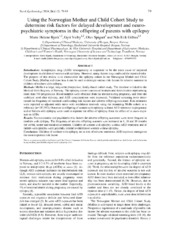| dc.contributor.author | Bjørk, Marte Helene | en_US |
| dc.contributor.author | Veiby, Gyri | en_US |
| dc.contributor.author | Spigset, Olav | en_US |
| dc.contributor.author | Gilhus, Nils Erik | en_US |
| dc.date.accessioned | 2020-05-07T09:20:36Z | |
| dc.date.available | 2020-05-07T09:20:36Z | |
| dc.date.issued | 2014-12-29 | |
| dc.Published | Bjørk MH, Veiby G, Spigset O, Gilhus NE. Using the Norwegian Mother and Child Cohort Study to determine risk factors for delayed development and neuro-psychiatric symptoms in the offspring of parents with epilepsy. Norsk Epidemiologi. 2014;24(1/2):79-89 | eng |
| dc.identifier.issn | 0803-2491 | |
| dc.identifier.issn | 1891-5477 | |
| dc.identifier.uri | https://hdl.handle.net/1956/22119 | |
| dc.description.abstract | Introduction: Antiepileptic drug (AED) teratogenicity is suspected to be the main cause of impaired development in children of women with epilepsy. However, many factors may confound the reported risks. The purpose of this review is to characterize the epilepsy cohort in the Norwegian Mother and Child Cohort Study (MoBa) and show how it can be used to detangle various risk factors for adverse outcome in children of mothers with epilepsy. Methods: MoBa is a large, long-term prospective, family-based cohort study. The database is linked to the Medical Birth Registry of Norway. The epilepsy cohort consists of mothers and their children representing more than 700 pregnancies. Blood samples were obtained from the mother during pregnancy and from the umbilical cord after delivery, and AED concentrations were measured. Validated screening tools determined the frequency of maternal confounding risk factors and adverse offspring outcomes. Risk estimates were reported as adjusted odds ratios with confidence intervals using the remaining MoBa cohort as a reference (n=107,597). Outcome in offspring of women with epilepsy without AED treatment in pregnancy and of fathers with epilepsy were used to separate the effect of epilepsy from the effect of in utero exposure to AEDs. Results: Socioeconomic and psychiatric risk factors for adverse offspring outcomes were more frequent in mothers with epilepsy. The frequency of adverse offspring outcome was increased at 6, 18 and 36 months for verbal, motor and social development. Children of women with epilepsy without AED treatment and of fathers with epilepsy were generally similar to children of women without epilepsy. Conclusion: Children of mothers with epilepsy are at risk of adverse outcomes. AED exposure emerges as the most important risk factor. | en_US |
| dc.language.iso | eng | eng |
| dc.publisher | Norsk forening for epidemiologi | eng |
| dc.relation.uri | http://www.ntnu.no/ojs/index.php/norepid/article/download/1806/1803 | |
| dc.rights | Attribution CC BY | eng |
| dc.rights.uri | https://creativecommons.org/licenses/by/4.0/ | eng |
| dc.title | Using the Norwegian Mother and Child Cohort Study to determine risk factors for delayed development and neuro-psychiatric symptoms in the offspring of parents with epilepsy | en_US |
| dc.type | Peer reviewed | |
| dc.type | Journal article | |
| dc.date.updated | 2019-10-29T15:02:02Z | |
| dc.description.version | publishedVersion | en_US |
| dc.rights.holder | Copyright 2015 Norsk epidemiologi | |
| dc.identifier.doi | https://doi.org/10.5324/nje.v24i1-2.1806 | |
| dc.identifier.cristin | 1205327 | |
| dc.source.journal | Norsk Epidemiologi | |
| dc.subject.nsi | VDP::Medisinske fag: 700::Helsefag: 800::Epidemiologi medisinsk og odontologisk statistikk: 803 | |
| dc.subject.nsi | VDP::Midical sciences: 700::Health sciences: 800::Epidemiology, medical and dental statistics: 803 | |

